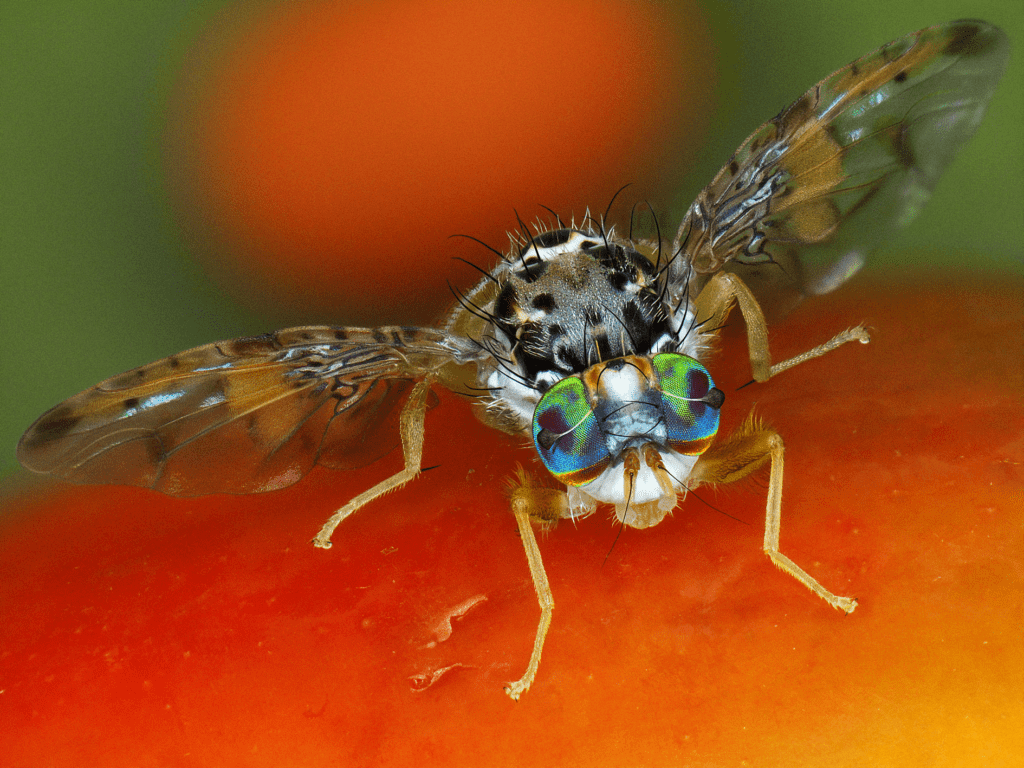
Male Ceratitis capitata
Utilizing a pest to fight itself
3 March 2023
REACT aims to break innovative ground in the ecological control of invasive insect pests in Europe and worldwide.
Invasive species of fruit flies pose a significant risk to agriculture. They feed on a wide range of fruits and vegetables, causing significant damage to crops. The feeding damage reduces the quality and market value of the produce.
The spread of invasive pests in Europe can lead to trade restrictions and quarantine measures, impacting European fruit and vegetables export. In its approach to develop ecological pest mitigation tools, the REACT project focuses on two fruit fly species Bactrocera dorsalis and Bactrocera zonata and draws on experience from other parts of the world.
Aruna Manrakhan is a Research Entomologist at Citrus Research International in South Africa. “We had Bactrocera dorsalis reaching the South African northern borders in 2010 and we eradicated it following an approved action plan,” she explains. “Eventually, there were more incursions and the pest became established in the northern parts of the country. Some southern parts of the country are still free of Bactrocera dorsalis. So we have interesting scenarios with regard to pest presence and pest absence within the country that could benefit REACT.” The status of Bactrocera dorsalis in South Africa allows important information to be drawn about the control of the pest species.
To mitigate the risks posed by fruit flies, European fruit growers rely on a combination of cultural practices, such as crop rotation and the use of insect-proof netting, as well as chemical controls, such as pesticides. However, developing resistance to pesticides by fruit fly populations is a growing concern, highlighting the need for alternative control methods, such as the Sterile Insect Technique, which REACT utilizes in its approach.

Cristina Borghesi, Ph.D. student at the Justus Liebig University in Giessen, Germany
Free from pesticides
The Sterile Insect Technique (SIT) is a biological pest control method that involves mass-rearing, sterilizing, and releasing sterilized males of the invasive pest insect into the target environment. The sterilized males mate with female pests, producing offspring that do not survive, thus reducing the pest population over time. Its potential to reduce the use of pesticides is one of SIT’s key benefits. Pesticides can have negative impacts on the environment and human health, and can also lead to the development of pest resistance. By reducing pest populations through SIT, the need for chemical pesticides can be reduced significantly.
For Cristina Borghesi, a Ph.D. student at the Institute for Insect Biotechnology at the Justus Liebig University in Giessen, this is where the most significant potential of the REACT project lies: “I’ve been in the agricultural field for a very long time. My whole family comes from agriculture. And I see the impact that pesticides and other chemicals have on agriculture. Many farmers don’t have alternatives in fighting pests. SIT and the REACT project aim to develop alternative tools that can be used to target pest species that would usually require enormous amounts of chemicals. Ultimately, we can have a cleaner environment with more diverse and beneficial species, such as bees and wasps, that remain unharmed. In my opinion, SIT has great potential in pest management and will be essential for sustainable pest control in the future.”
SIT is specific to the target pest species, meaning that it does not harm beneficial insects or other wildlife. This makes it a more environmentally-friendly alternative to broad-spectrum pesticides.
SIT has been successfully and cost-efficiently applied to various insect pests since its first applications in the 1950s, including pests affecting crops, forests, and livestock. However, implementing SIT for new species requires significant time and resources, including developing mass-rearing facilities and releasing millions of sterilized insects. In the end, it is also the cost that determines the success of the method, knows Aruna Manrakhan: “You could develop many technologies, but in the end, if it’s too expensive, farmers will choose another option. The affordability hast to be factored in.”

Gur Pines, researcher at the Agricultural Research Organization, Israel
Identification is key to react
REACT proposes to improve the cost-effectiveness of SIT programs and enable the implementation against more pest species by creating a bioinformatic pipeline to construct genetic sexing strains (GSS) based on a highly conserved pupal marker. We call the use of knowledge from classical GSS from successful SIT programs and developing those with novel tools for new pest species the ‘neoclassical approach’. Combining the SIT strategy and Gene Editing technologies can create new, improved sexing strains for the use in biological pest control.
Of course, to successfully control invasive insect pests, you first have to recognize them. And ideally, this should happen even before they can fly and spread. This means: that potentially dangerous fruit flies must be detected as larvae. To this end, rapid tests are being developed as part of the EU-funded REACT project.
“My part in this giant project is to develop fast, reliable and affordable bio-sensors,” explains Gur Pines, a scientist at the Israeli Agricultural Research Organization. “They can be used at border controls or farmers to quickly detect when and where insect pests arrive.”
The bio-sensors are based on the CRISPR technology, known for its gene-editing properties. REACT does not use CRISPR for genome editing, but for detection. When farmers or e.g. port authorities find fly larvae, they usually don’t know exactly which fruit fly they are looking at, because many species look pretty similar. The REACT rapid tests are designed to detect the gene sequences that identify the fly species beyond doubt. As with a corona PCR test, the test then shows whether it is one of the dangerous invasive species.
Gur Pines: “We have already demonstrated this technology on two different fruit flies and it seems to work well. In REACT we want to extend our approach to more fruit flies with invasive potential. Still, there are many challenges in this. We don’t have a published sequence available for some of the pests we’re interested in. The bio-sensor is relying on sequence information. As long as we don’t have it, we cannot detect it. Bactroceradorsalis and zonata are very closely related evolutionary. The more sequence we get, the better will the detection work in distinguishing between them.” This is why the REACT project also works on sequencing.
If successful, the REACT project could provide European farmers with a practical yet ecological tool for controlling pests.
